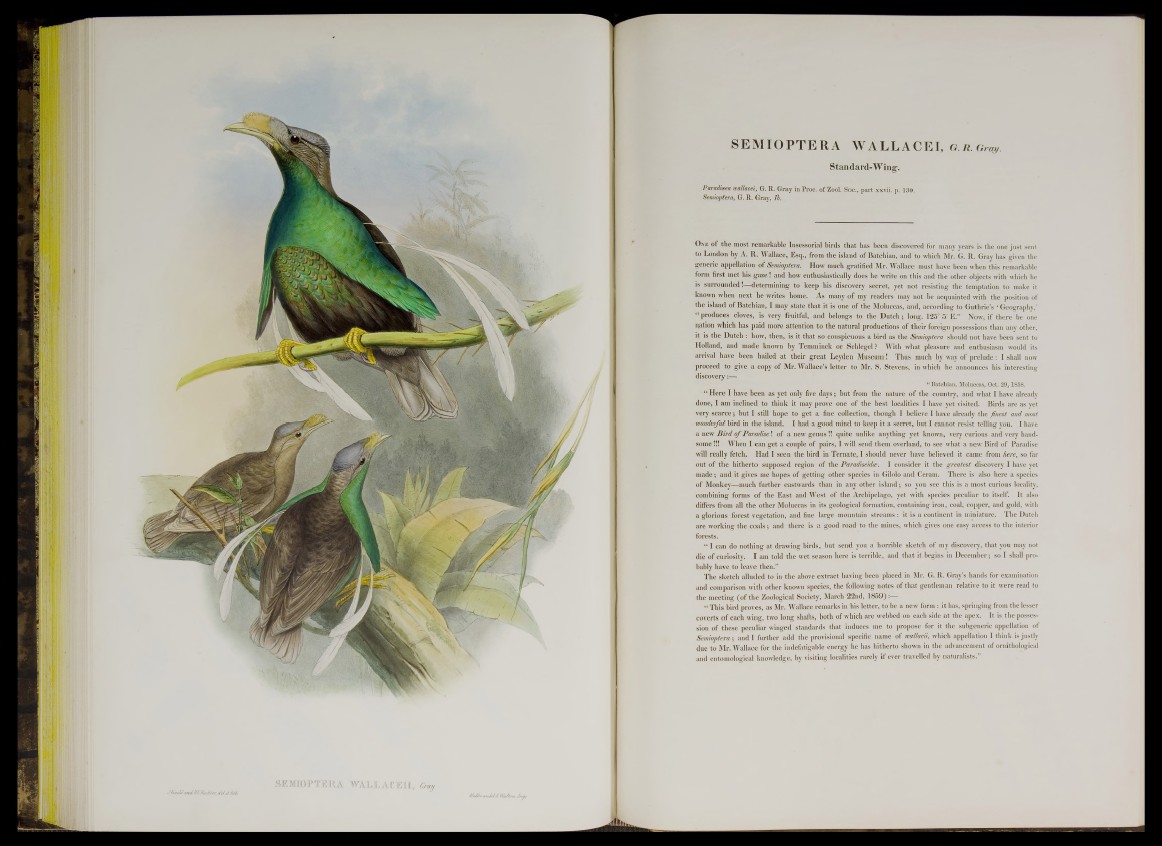
SEMIOPTERA WALLACEI , G.R.Gray.
Standard-Wing’.
Paradisea wallacei, G. R. Gray in Proc. of Zool. Soc., part xxvii. p. 130.
Semioptera, G. R. Gray, II.
O n e of the most remarkable Insessorial birds that has been discovered fo r many years is the one just sent
to London by A. R. Wallace, Esq., from the island of Batchian, and to which Mr. G. R. Gray has given the
generic appellation of Semioptera. How much gratified Mr. Wallace must have been when this remarkable
form first met his gaze! and how enthusiastically does he write on this and the other objects with which he
is surrounded!—determining to keep his discovery secret, yet not resisting the temptation to make it
known when next he writes home. As many of my readers may not be acquainted with the position of
the island of Batchian, I may state that it is one of the Moluccas, and, according to Guthrie’s * Geography,’
“ produces cloves, is very fruitful, and belongs to the Du tch ; long. 125° 5' E.” Now, if there be one
nation which has paid more attention to the natural productions of their foreign possessions than any other,
it is the Dutch : how, then, is it that so conspicuous a bird as the Semioptera should not have been sent to
Holland, and made known by Temminck or Schlegel? With what pleasure and enthusiasm would its
arrival have been hailed at their great Leyden Museum! Thus much by way of prelude: I shall now
proceed to give a copy of Mr. Wallace’s letter to Mr. S. Stevens, in which he announces his interesting
discovery:—
“ Batchian, Moluccas, Oct. 29,1858.
“ Here I have been as yet only five days; but from the nature of the country, and what I have already
done, I am inclined to think it may prove one of the best localities I have yet visited. Birds are as yet
very scarce; but I still hope to get a fine collection, though I believe I have already the finest and most
wonderful bird in the island. I had a good mind to keep it a secret, but I cannot resist telling you. I have
a new Bird o f Paradise! of a new genus!! quite unlike anything yet known, very curious and very handsome
!!! When I can get a couple of pairs, I will send them overland, to see what a new Bird of Paradise
will really fetch. Had I seen the bird in Ternate, I should never have believed it came from here, so far
out o f the hitherto supposed region of the Paradiseidce. I consider it the greatest discovery I have yet
made; and it gives me hopes of getting other species in Gilolo and Ceram. There is also here a species
of Monkey—much further eastwards than in any other island; so you see this is a most curious locality,
combining forms of the East and West of the Archipelago, yet with species peculiar to itself. It also
differs from all the other Moluccas in its geological formation, containing iron, coal, copper, and gold, with
a glorious forest vegetation, and fine large mountain streams : it is a continent in miniature. The Dutch
are working the coals; and there is a good road to the mines, which gives one easy access to the interior
forests.
“ I can do nothing at drawing birds, but send you a horrible sketch of my discovery, that you may not
die of curiosity. I am told the wet season here is terrible, and that it begins in December; so I shall probably
have to leave then.”
The sketch alluded to in the above extract having been placed in Mr. G. R. Gray’s hands for examination
and comparison with other known species, the following notes of that gentleman relative to it were read to
the meeting (o f the Zoological Society, March 22nd, 1859):—
“ This bird proves, as Mr. Wallace remarks in his letter, to be a new form : it has, springing from the lesser
coverts of each wing, two long shafts, both of which are webbed on each side at the apex. It is the possession
of these peculiar winged standards that induces me to propose for it the subgeneric appellation of
Semioptera; and I further add the provisional specific name of wattacii, which appellation I think is justly
due to Mr. Wallace for the indefatigable energy he has hitherto shown in the advancement of ornithological
and entomological knowledge, by visiting localities rarely if ever travelled by naturalists.